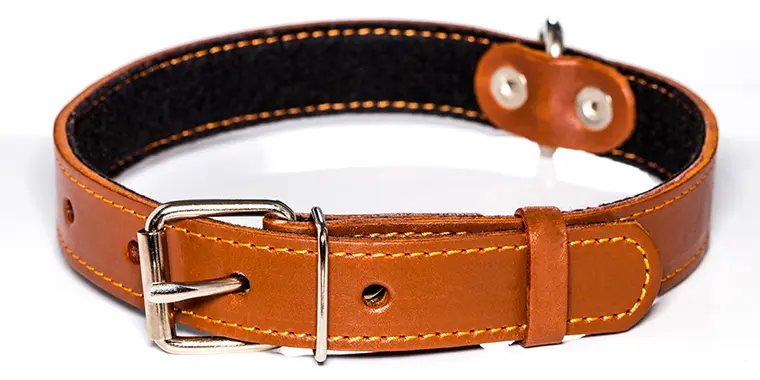
Dog owners are confronted with various dog collars today. You can find thousands of different designs of regular dog collars alone. In addition, there is a wide range of specialized training collars. This can make it confusing as to what dog collar to choose.
Especially training collars enflame all kinds of passions with certain groups. Some call them cruel, barbaric, or inhumane. Let’s take an objective look at dog collars and their purpose for dog training. Further, we review the rationale behind them.
I want to acknowledge that any dog collar can be abused, which is unacceptable. But that is hardly an argument against effective training tools when used correctly. You can abuse anything. You can carve someone’s eyeball out with a teaspoon. That is not an argument against teaspoons. I advocate proper education and training and using training collars responsibly and correctly. I encourage you to hire a professional dog trainer to teach you what training collar is appropriate for your dog and how to use it correctly.
First, let’s review a few general things about dogs, as they are relevant when discussing dog collars.
Dog Basics
In many parts of the world, people tend to view their dogs as other kids of the family. Generally speaking, that is a good attitude. The Canadian clinical Psychologist Dr. Jorden B. Peterson said in an interview with British GQ:
The fundamental issue among knowledgeable animal behaviorists is that the anthropomorphization with animals is generally the appropriate tactic unless you have reason to doubt it. Because there is continuity between animals and us rather than discontinuity. The idea that anthropomorphization of animals is inappropriate is something derived from 1950s behaviorism.
– Dr. Jorden B. Peterson
Emotions Matter
Consequently, considering how your dog feels about something is highly appropriate. However, some people take this too far and focus on irrelevant things. Dogs and people care about different things. Loving a dog means accepting its nature and providing it with what it needs and not what we think it should enjoy.
Your dog doesn’t care if it has a fancy collar with little pearls, special clothing, a big house, drives in a Mercedes, or has golden dog bowls. It doesn’t care if you are a CEO who rules a business empire. These types of things mean something to people but not to dogs. Our dogs only experience us through the energy—think ‘state of mind’ or ‘demeanor’—we share with them and the things we do with them. If we are fun to be around, we will have a great relationship with our dogs.
Clarity Matter
Dogs enjoy clarity. They don’t mind rules as long as they are clear, consistent, and fair. For a dog, rules start right after birth, when the mother teaches him how far he can wander off. She teaches her puppies what they get to do and what not. It is normal for dogs to have rules to follow when they live amongst themselves. Hence, it is good to establish clear rules for your home also. The better your dog understands what is permitted and what isn’t, the more harmonious your relationship will be.
What those rules are, is up to you. Do you allow your dog on the sofa or not? Does he sleep in bed with you or not? Do you crate him when you leave or not? Is he heeling to the left or right of you? There are no right or wrong answers to things like that. You decide. It’s not a problem unless it’s a problem. For example, if your dog sleeps peacefully in bed with you, there is no reason not to continue that. However, if your dog bites your ankles when you move your feet during the night, that’s a problem. That would need to be addressed before he can safely return to the bed.
How Dogs Handle Rule Violations
How do dogs respond when one of them violates the rules? They reprimand each other. As they don’t have a language like us, they use their body to communicate. A mother dog will pick her pups up by the neck—with her teeth—and carry them back to the nest. Dogs will playfully bite each other in the neck during games. Dogs will bite and hold each other by the neck with their teeth in a dispute. I guess by now, it’s obvious where I am going with this. Dogs correct one another by biting each other in the neck. That doesn’t mean they puncture the skin or draw blood. But the bite to the neck is genetically programmed behavior and psychologically means to a dog, “Don’t do that.”
Many training tools simulate this neck bite communication using collars and leashes. Many training collars were invented for this purpose, and some simulate a corrective bite more directly and effectively than others.
So let’s review the main dog collar types and what they are good for.
Regular (Flat) Collars

These are collars for well-behaved dogs that don’t pull on the walk and don’t lunge at other dogs. Dogs that don’t bark at everything and just walk nicely with you. These collars are usually good for well-trained or older dogs. These collars are often not great for dogs with many behavioral issues unless you know a lot about learning science. A skilled trainer can accomplish a lot on a regular collar. An unskilled trainer won’t. You should eventually strive to graduate your dog to this dog collar—view them as a graduation gift.
Some corrective collars can be unsuitable for younger and more sensitive puppies, so regular collars can also be good. However, when puppies become too rambunctious, it makes sense to evaluate corrective collars also—especially with larger and more powerful (meaning stronger) breeds.
Agitation Collars
The wider versions of these collars (i.e., 1.5 inches or wider) are called agitation collars. They don’t cause agitation but allow it without conflict. The wider ones are often used when training protection, police, and military dogs but also in behavioral training.
Choke Collars (aka Check Collars)

Choke collars are also referred to as check collars. The term choke collar, however, is unfortunate for these types of collars. As choking—meaning, prolonged cutting off of the airflow—is precisely what you shouldn’t do with these collars (except in emergencies). But given the way they work, the name stuck. As you can see in the pictures, the collar allows exerting pressure around a dog’s neck—a simulated bite—to deliver a penalty.
How to Use Them
The proper way to use such a corrective collar is by generally keeping it loose and only contracting it briefly—with a short, firm check—when a penalty is needed. That way, the contraction stimulates the neck bite we discussed earlier. The short, firm pull can’t be too soft, or you won’t get your dog’s attention. It should also not be too firm, as that can de-motivate a dog during training. You’ll find the right balance and firmness of a penalty for your dog through practice, and I recommend seeking professional advice before using this or any other corrective dog collar.
Placement
The most effective position for a choke collar is higher up on the dog’s neck, but it shouldn’t be kept under constant tension. It should be loose, and that means lower. The neck is most sensitive right under the jaw—behind the ears, not like in the picture. As this is a more sensitive part of a dog’s neck, you must carefully test how much pressure is necessary for an effective penalty. Always start with the minimum amount possible for the best response. It is better to start with too little force and adjust upward to the correct strength than by starting to firmly and create problems.
Certain trainers—primarily those who lack experience with unruly dogs of large, powerful breeds—might want to persuade you not to use choke collars, but it is your dog. If you have problems controlling it and feel a corrective collar would be appropriate, you can always find a trainer to help you understand how to work these best and teach you.
Fur-Saver Collars

The most common choke collars professionals use are the Fur Saver collars from the German company Herm Sprenger. The Fur Savers (picture to the left) won’t pinch the fur—especially important for thick-furred dogs like German Shepherds or Huskies—and they will not break. I have never heard of a Herm Sprenger Fur Saver that broke, ever. However, I have seen many cheaper collars from pet chain stores break at the worst possible moment. The Fur Savers will last the lifetime of your dog and beyond. I used the Fur Savers with my German Shepherds in the past and have complete confidence in their performance. Even if 90 pounds of muscle try to do something they shouldn’t.
The wider collar links also distribute the pressure better, so any injury to a dog’s throat—like a thinner chain could cause—is less likely. Fur Savers have two rings to which you can connect the leash: a ‘Live’ ring and a ‘Dead’ ring. If you connect the leash to the ‘Live’ ring, you can use the ‘check’ functionality of the collar. If you connect it to the ‘Dead’ ring, it acts just like any regular collar without corrective functionality. So the Fur Saver is a versatile, reliable collar for all occasions.
Training Option
Fur Savers cost between $20 to $30 and are well worth it, in my view. I got mine at a dog sport club, where I used to attend weekly obedience classes with my German Shepherd Dog for behavior maintenance. If you have a large breed dog, dog sport clubs can be great places for regular behavior reinforcements. You can work with your dog among like-minded people and dogs of the same power level. It is a serious training environment for responsible dog owners and superior to what pet stores offer. Especially for behavioral issues with large breed dogs, I recommend checking with local dog sport clubs for public obedience lessons. Of course, private lessons with a good trainer are always the best way to go but are more costly than the other suggestion.
If you try a dog sport club, just make sure you like how people treat and handle dogs. Never let anyone do anything to your dog you are not 100% on board with. No matter how much more experience you believe that trainer has.
Prong Collars (aka Pinch Collars)
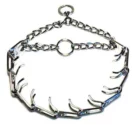
Everything mentioned above for choke collars also applies to prong collars. The difference with a prong collar is the prongs and how the contraction works. The idea is the same as above, but now you are adding the feeling of another dog’s teeth to the bite simulation. When looking at the prongs, remember that these are made for dog necks, with much looser skin than our own. Dogs have leathery skin and fur on their necks, we don’t. Dogs also have hundreds of muscles in their neck. Despite their skin being thinner than that of humans, their necks are simply way sturdier. A good prong collar will not injure a dog if used correctly.
There are significant differences between prong collars. The ones you see hanging in pet chain stores are probably the worst you can ever buy. However, despite their look, a proper, well-fitted, prong collar is the mildest mechanical correction tool you can use due to its neck pressure points and martingale design. These collars distribute all pressure evenly around your dog’s neck and don’t cut off its airflow. They may look horrible but are safe, great training collars when used correctly.
Selecting the Correct Collar
Generally, the prongs should be dull and rounded—never sharp or pointy. Fitting the collar correctly is also very important. A properly fitted prong collar can’t be pulled over a dog’s head—it must be opened and closed around your dog’s neck.
Prong collars don’t have to sit on the top of the neck, as some claim. It should be a loose fit. However, a high placement can make things easier with large, powerful dogs. The high spot significantly reduces the force required for an effective penalty. As the prongs deliver a bite simulation with teeth, the force required for a penalty is lesser than the force you would need with a normal choke collar. As with any corrective collar, in the beginning, start with less force and slowly increase it until you get the penalty response from the dog you are looking for.
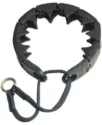
Prong collars come with pointy (not recommended) or dull (recommended) prongs, and models are made from various materials. If you decide these are appropriate for your dog, pick a sturdy model. I have very low confidence in the hard plastic versions, but I have never seen them break. I would again recommend the Herm Sprenger prong collars as these people know how to make reliable equipment. Prong collars are serious, advanced training tools. I strongly recommend discussing the proper usage with a skilled trainer BEFORE using one.
I have seen these collars work very well with some dogs and not at all with others. It is important to understand that prong collars can be part of the problem when working with an aggressive or fearful dog. Especially if you are not making progress in changing its behavior. Like with any corrective collar, a skilled trainer will always evaluate if this collar is suitable for your dog or not.
Martingale Collars
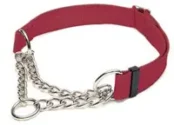
Martingale collars work like choke collars but with two key differences. They give you the ability to control the maximum contraction. Further, they distribute all pressure evenly around the neck. You can see in the picture that the extent of the contraction is limited. You can adjust the neckband to deliver more or less pressure or none. While the Martingale will always contract, it can be adjusted not to deliver any pressure around a dog’s neck when fully contracted.
This makes it a versatile tool, and it is very popular with many dog owners. I have had good experiences in effectively penalizing dogs with this type of collar and used one on my pitbull when she was a puppy in a non-pressure setting. Hence, she didn’t get penalized in full contraction. She did sometimes become a bit unruly on walks, and then it was a quick matter to tighten it a bit to a light contraction setting.
I also used a Martingale with one of my German Shepherds before I moved him to a Fur Saver. I made that move primarily because I trust the Fur Safer more for my dog’s power. Also, a K9 handler I trained with once told me, “Just because this hasn’t broken, doesn’t mean it can’t”—good point. I view having a powerful dog as a beautiful responsibility. As a responsible dog owner and dog trainer, I have to ensure everyone’s safety in all situations.
As a consequence, I switched to this stronger collar. I generally view Martingales as good corrective collars for medium or smaller-size dogs. When selecting a Martingale, I highly recommend getting a snap-on version, as otherwise, you have to reconfigure it every time you want to take it off— that gets annoying fast.
Electronic Collars (aka e-Collars, aka Shock Collars)
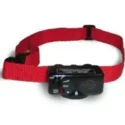
e-Collars are probably the most contentious of all corrective collars and enflame strong emotions among many people. In my view, this is unjustified and driven by a lack of understanding. But they are advanced training tools and should never be used on a dog unless you know what you’re doing. While proper use of an e-Collar can make a world of difference in the right circumstance. It can be a disaster in the wrong situations.
I STRONGLY advise consulting an experienced dog trainer BEFORE buying or using one of these—this is not a tool for just anyone.
The Different Types
First, the more commonly used term e-Collar stands for ‘electronic collar,’ but that does not mean electrocution collar. These collars came out of gun dog training—aka hunting dog training—as a way to direct a dog over a mile away from you. Over time we discovered many other applications of these tools. E-Collar contains an electronic mechanism to deliver one of four types of possible penalties: Static, Vibration, Ultrasonic, and Spray.
Often, e-Collar combine static and vibration in one collar, but generally, these are the four different types of e-Collar on the market. The spray e-Collars were all the rage when they first came out. But as they didn’t work well, people didn’t buy them. Today they are hard to find. That is a good thing. They were a foolish idea for many reasons.
Most e-Collars consist of two parts, a collar that goes around the dog’s neck (obviously) and a remote control that allows stimulation from a distance. The e-Collar control usually has multiple strength settings and one alternative setting, a tone or vibration only. E-Collars should always be used on the lowest level possible but at the highest level necessary to achieve the goal. They are aversive tools. That is the point. When used correctly, a dog learns to avoid the aversive stimulation by adjusting its behavior. As with all corrective collars, start at a low level and increase as needed—meaning, when your dog does not react at a setting, you go higher the next time.
Static e-Collars
These e-Collars are the ones most people think of when they hear e-Collar or shock collar. However, many still believe they deliver an electric shock, which they do not. These collars deliver a static shock. If you want to know what that feels like, put on some wool socks, walk over a carpet, and touch an ungrounded metal object. Or, at one point or another, most of us got zapped after getting out of our fabric car seat and touching the door handle. That’s the same thing.
Vibration e-Collars
Vibration is usually an additional feature of static collars and is used as an alternative setting. This vibration is often conditioned with food as a positive marker but can be used in various ways. For example, when training a deaf dog, the vibration can be used as a signal to look at us so we can give further commands with hand signals. However, the vibration can be more disturbing to some dogs than a low-level static shock. So don’t assume vibration is benign. In the last couple of years, we have also seen several vibration-only collars hit the market. These are interesting. e-Collar Technologies carries a model with 100 different vibration strength settings. I used one with a deaf dog once, and it worked great with that girl.
Ultrasonic e-Collars
These systems aren’t actual collars but often just remote controls. An ultrasonic system distracts your dog without using a receiver collar. When your dog misbehaves, you press a button on the remote. It emits a loud, annoying sound that disrupts your dog’s actions. However, this is not a precise tool and will also impact any other dog standing nearby. I find this collar not that useful. Having said that, we have a pitbull in the family for whom this is highly effective. So, never say never.
Spray e-Collars
These collars spray an unpleasant lemon-scented spray on the dog as a penalty. The biggest problem with these is the duration of the penalty. The lemon spray is unpleasant for an extended period. This violates what learning science has established as the proper application of penalties. They should be short and intense, followed by a longer recovery period. These have disappeared from the market as they did not work well, and people didn’t buy them.
This was a quick overview of what’s generally available in the remote collar category. So how and why do these make sense?
e-Collars allow you to deliver a meaningful penalty to a powerful dog without forcing you to yank on a leash with force. The main benefit is that it allows you to remain calm while still being able to penalize your dog effectively. It’s also way milder than a physical jerk on a collar.
This brings me to another point on e-Collars that critics often overlook. These collars were not invented for Cocker Spaniels or Toy Poodles. If we just had dogs like those, we probably wouldn’t have come up with these tools in the first place. e-Collars, like many other corrective collars, were born from the necessity of needing to control the unrelenting power some breeds possess. Or to control a dog at a distance—for example, hunting dogs. If you have to work with large dogs with aggression issues, these tools allow doing what is necessary and might otherwise not be possible. The entire point is to deliver a penalty of the proper intensity as part of a training protocol.
E-Collars are great tools for the right circumstances and in the right hands and a real problem in the wrong hands. The biggest issue is their overuse, especially the low-level stim conditioning that too many trainers still use. Further, YouTube is full of poor examples by macho trainers of how not to use them.
The Packleader Collar™ (aka Illusion-Collar™)
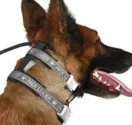
The Packleader Collar from Cesar Millan is a newer innovation in dog collars. This collar is essentially a modern form of a choke collar, but it offers several differences from a regular choke or martingale collar. As you can see in the picture, it consists of two bands running across your dog’s neck and three stiff connectors that keep them apart and in place. This allows the actual collar rope—that connects to the leash—to remain high up on the dog’s neck, where it is most effective and requires the least amount of force. At $45, they don’t come cheap, but they do what they are designed to do. I don’t find them useful.
The Head Collar (aka Halti™, aka Gentle Leader™)

The Head Collar is designed to pull your dog’s head to the side when it pulls forward. This is quite unpleasant to your dog. Walking with this type of collar is like having a loaded gun pointed at your head the whole time. It is mind-boggling this became a favorite tool of force-free trainers. It is highly aversive. The high injury risk of yanking the dog’s head sideways is deeply problematic.
Harnesses

Harnesses are for pulling. These are great if you want your dog to pull you all over the place. Otherwise, stay away from harnesses for dog walking unless your dog is a good leash walker. Especially when dealing with behavioral issues, harnesses can be dangerous. Dogs can get out of many harness models. There is a reason they use harnesses on sled dogs—it allows them to pull well.
Proper use of harnesses is for your dog’s safety during car rides. Use it so your dog would be caught by the harness if you have to stop suddenly. Harnesses are great for tie-outs for protection/agitation/police dog training, mill racing, and sled pulling. Some harnesses also allow attaching carrying bags, which is wonderful for hiking. Harnesses can also be great for young puppies.
Harnesses don’t allow for much control you would otherwise have with a collar. Hence, this is not the way to go if you need control. This also applies to the so-called no-pull-harnesses. They make it more challenging for a dog to pull but by no means prevent it. Dogs love a good challenge.
Dog owners often use harnesses out of concern for their dog’s neck or because a veterinarian suggested it. The dog was choking itself on other collars. As a result, they use a harness and avoid the issue. Instead, a better approach would be to teach the dog not to pull in the first place.




